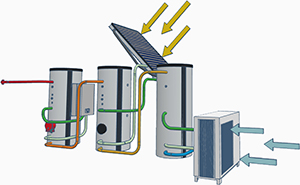Because of the ubiquitous need for domestic hot water (DHW) in commercial building projects – which can account for as much as 30% of a building’s daily energy demands – addressing how it is secured is one of the best ways of making active carbon savings today. Looking forward, new build projects, unless exhibiting very large hot water demands, will struggle to receive permission (under Part L of the building regulations) for a new gas connection and as a result will specify electric-based systems. Larger retrofit projects could likely face the same issues, meaning many pre-existing commercial buildings, 80% of which are expected to still be in use by 2050, will eventually face the singular challenge of transitioning from gas to electric. This still should lead to application design tending towards that which blends heat pumps for preheat with other sustainable options that can include solar thermal, but particularly electric boilers.
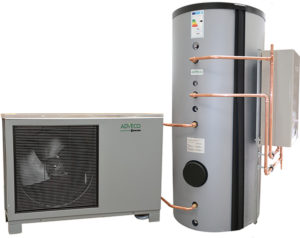 Hot water specialists Adveco has been working with a range of commercial organisations, to meet the challenge of better understanding existing systems by non-invasive ultrasonic flow metering. This is necessary if accurate system replacements are to be designed that balance the ratio of available electric power and hot water storage required without exceeding the building’s existing electrical supply.
Hot water specialists Adveco has been working with a range of commercial organisations, to meet the challenge of better understanding existing systems by non-invasive ultrasonic flow metering. This is necessary if accurate system replacements are to be designed that balance the ratio of available electric power and hot water storage required without exceeding the building’s existing electrical supply.
Deploying heat pumps and/or solar thermal as a renewable to provision the initial preheat, is the most logical approach to achieving sustainable water heating, but this is adding further complexity to a process that typically demands a bespoke approach. With accurate data gathering, it becomes possible to provide the most feasible system design that demonstrates predicted carbon reductions and optimises capital investment.
FUSION
To simplify matters, FUSION from Adveco is a complete range of packaged electric and packaged renewable electric water heaters for commercial projects. As an all-electric system, it uses familiar technology that is relatively simple and quick to install, cost-effective and reduces carbon emissions.
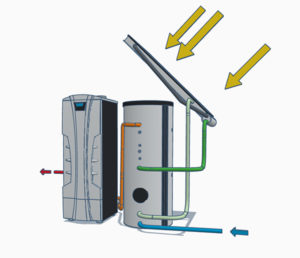 With a heating capacity of up to 34 kW, FUSION systems offer greater versatility for meeting DHW demands across a range of commercial properties. Projects with small to medium basin and sink-led hot water demands – such as cafes, restaurants offices or gyms – taller buildings with basement plant rooms and organisations that depend on 24/7 hot water provision for continuity of service all gain advantages from using FUSION.
With a heating capacity of up to 34 kW, FUSION systems offer greater versatility for meeting DHW demands across a range of commercial properties. Projects with small to medium basin and sink-led hot water demands – such as cafes, restaurants offices or gyms – taller buildings with basement plant rooms and organisations that depend on 24/7 hot water provision for continuity of service all gain advantages from using FUSION.
FUSION starts with all new specially designed single- (ATSI) or twin-coil (ATST) corrosion-resistant stainless steel high-pressure indirect cylinders. Offering capacities from 200 to 500 litres, the cylinders feature dedicated mounting points for Adveco’s 9, 12 or 24 kW ARDENT electric boiler making FUSION-E a more compact, space-saving option. Supplied with pre-built pipework FUSION is now faster and easier to install.
For the FUSION-T renewable variants, the monobloc air-to-water FPi-32 heat pump (ASHP) is used as a source for system preheat. Contribution from the ASHP is maximised via the bespoke FUSION Control Box. These controls smartly balance the two heat sources, meaning the electric boiler is not required to work as hard to raise flow temperatures to the required 65°C. Electrical demand on the boiler is reduced by as much as 30%, delivering operational savings and reducing carbon emissions by up to 71%.
Where hot water demands become a business-critical service, FUSION systems can also incorporatare an additional backup immersion (FUSION-Eplus & FUSION-Tplus) for enhanced resiliency.
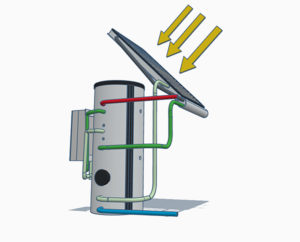 Replacing gas-fired water heating with an electric system currently has a number of cost implications. Correct sizing with metered data can be clearly shown to reduce the system requirements seen in oversizing, saving considerably on the cost of purchasing and installing new hardware. This potential saving can number in the tens of thousands of pounds depending on the scale and complexity of the hot water application. Operational costs do however climb – especially when using electrical immersions as the primary heat source, but also with heat pumps – and will continue to do so while grid electric prices remain much higher than those of gas grid supplies.
Replacing gas-fired water heating with an electric system currently has a number of cost implications. Correct sizing with metered data can be clearly shown to reduce the system requirements seen in oversizing, saving considerably on the cost of purchasing and installing new hardware. This potential saving can number in the tens of thousands of pounds depending on the scale and complexity of the hot water application. Operational costs do however climb – especially when using electrical immersions as the primary heat source, but also with heat pumps – and will continue to do so while grid electric prices remain much higher than those of gas grid supplies.
SOLAR HYBRIDS
Capable of offsetting typically around 30% of the energy demands for water heating, solar thermal systems are ideal for organisations which rely on large amounts of DHW and are seeking to reduce costs associated with electric-only systems. It also provides a way to further cut carbon emissions, not only from old gas-fired systems but new grid-based applications as well.
Modular, high-performance flat plate collectors are by far the most efficient way to heat water with solar energy, offering a smaller footprint compared to equivalent solar photovoltaics (PV) for DHW. A typical 4 kW PV system requires approximately 16 panels covering 25m² of roof to match just three flat plate collectors covering just 6.6m² roof area. This makes solar thermal a prime choice when roof or façade space is limited. A south-facing and unobstructed roof with an inclination of 30° from the horizontal is optimal, though by no means essential as modern solar collectors can be installed in a variety of permutations.
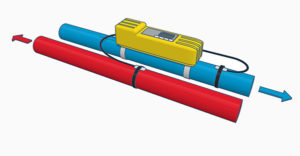 Adveco collectors feature a copper meander absorber through which passes the solar fluid (glycol) transferring solar energy as heat to the system’s water via an indirect cylinder. Collectors with an integrated drain back module, which prevents damaging overheating of the solar fluid, offer a low-maintenance, more cost-effective and more efficient approach to incorporating solar energy into a sustainability strategy.
Adveco collectors feature a copper meander absorber through which passes the solar fluid (glycol) transferring solar energy as heat to the system’s water via an indirect cylinder. Collectors with an integrated drain back module, which prevents damaging overheating of the solar fluid, offer a low-maintenance, more cost-effective and more efficient approach to incorporating solar energy into a sustainability strategy.
For existing buildings with gas-fired water heating solar thermal is employed as a system pre-heat, reducing demands for gas to actively cutting carbon emissions from the buildings. For new build properties with electrical connection, the gas heater is replaced with an electric boiler and cylinder to supply the afterheat which raises system temperatures to a necessary 60°C. This hybrid approach maximises the solar thermal input which Adveco has simplified by integrating a packaged FUSION E electric water heating system. The all-electric solar thermal approach further reduces carbon associated with grid electric systems and aids in lowering operating costs.
This hybrid approach can be further extended with the inclusion of air source heat pumps to provide the initial pre-heat for the system. Operating at lower temperatures with the cold feed maximises the efficiency of the heat pump, reducing electrical operating costs and raising working flow temperature from 10°C to 40°C. This is not hot enough for commercial applications, so the pre-heated water is then passed to the mid solar thermal system. Essentially free to operate, the solar thermal system boosts the working flow temperatures from 40°C to at least 50°C. Although not operating at maximum potential, there is enough advantage gained from solar thermal to warrant the additional system complexity and capital investment. During summer months it is possible for the solar thermal system to deliver the necessary 60°C working flow although a FUSION electric water heater is still required to ensure consistent water temperatures of up to 65°C year round.
First Steps
The application of renewables, whether heat pumps or solar thermal, or a combination of the two can reduce, but not completely offset all direct electric costs. The advantage is clearly defined in the reduction of carbon emissions. If considering a move to more sustainable operations, or faced with system refurbishment, data gathering on existing systems is still the simplest, low-cost first step you can take. It provides the intelligence and insight necessary for accurate, more considered decision-making.


